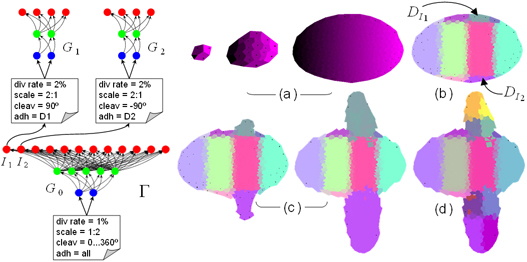Scaling in Biological and Social Networks - Abstract - Doursat
From Santa Fe Institute Events Wiki
| Workshop Navigation |
Multiscale Embryomorphic Architectures
The spontaneous making of an entire organism from a single cell is the epitome of a self-organizing, decentralized and multiscale complex system. Through the precise spatiotemporal interplay of genetic switches and cell biomechanics a reproducible, detailed architecture is created without explicit blueprint or external intervention. Recent dramatic advances on two fronts, the in vivo imaging techniques of embryogenesis and the genetics of developmental biology (combined with evolution in "evo-devo"), bring closer to reality the foundations of a future "generative developmental grammar". The goal is to unify the richness and endless diversity of biological forms as variations around a common theme. The variations are the specific parameters of the genome; the theme comprises the generic elementary laws, chemical and mechanical, by which this genome guides cell differentiation and self-assembly.
I will present an original model of embryomorphic system growth. A virtual organism is represented by a mass of cells that proliferate, migrate and self-pattern into differentiated domains. My work attempts to reproduce morphogenesis through a multiscale generative process. Starting with a few cells that express broad positional and identity domains, details are gradually added using only local information. At the same time, the medium is expanding. Each cell contains an internal gene regulatory network Γ and acquires specific gene expression identities I1, I2, ... by interaction with neighboring cells (see Figure). Different cell identities trigger different cell behaviors, which in turn induce new identities. The final organism's architecture depends on the detailed relationships between the various rates of cell division and adhesion, propagation of genetic expression and positional information.
By transfer to engineering, embryomorphic architectures also suggest a "fine-grain" approach to artificial systems design, i.e., one based on hyper-distributed collectives of a great number of very simple and relatively ignorant cloned elements (e.g., nano-units or software agents). It also stresses the fact that such collectives need not be homogeneous, but may contain a rich diversity of component types. Nor is their organization necessarily "flat", but rather modular and hierarchical across multiple scales of resolution in time and space.

